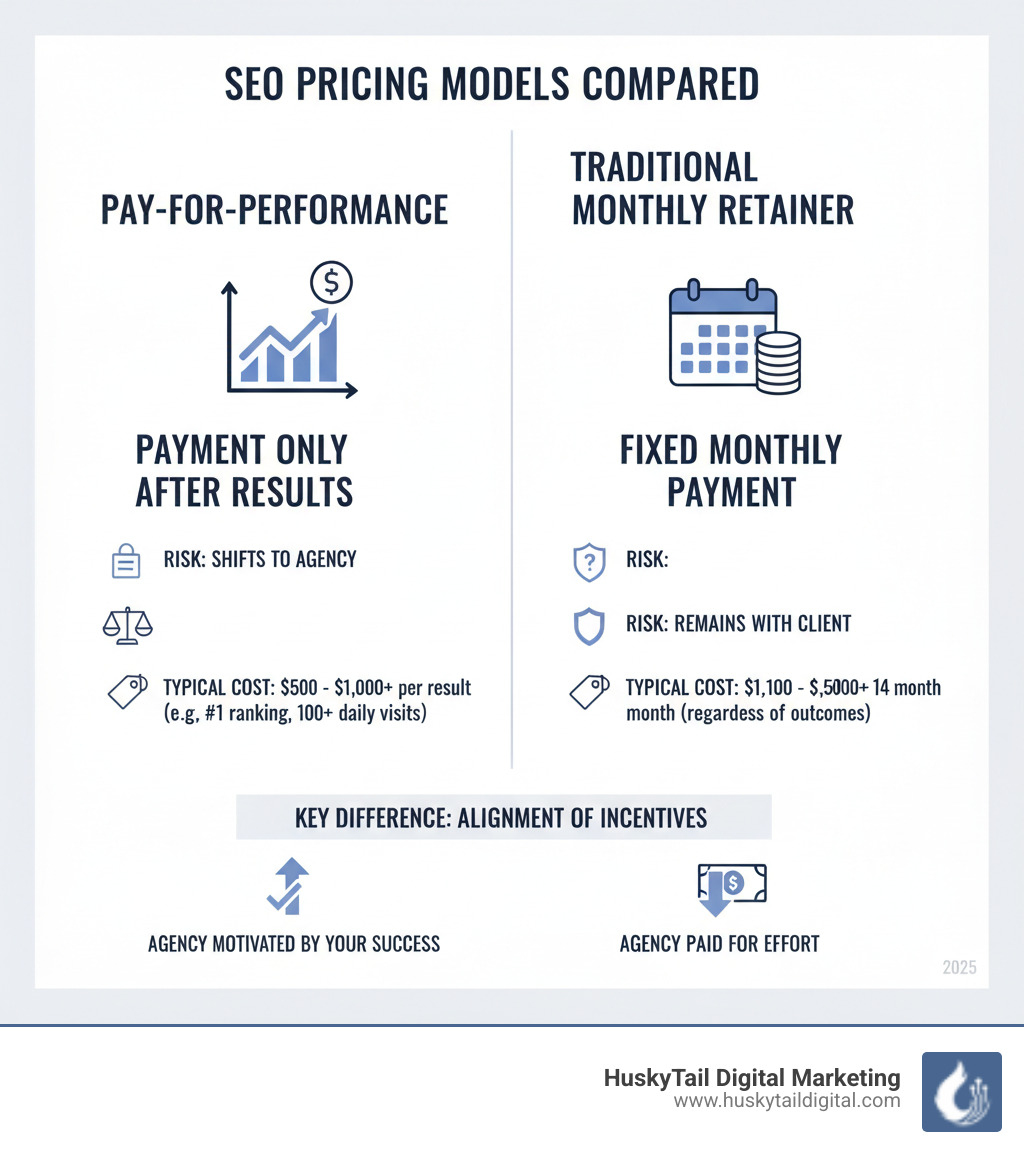Understanding Pay-for-Performance SEO: The Promise of Results-Based Marketing
Pay-for-performance SEO is a pricing model where businesses only pay their SEO agency when specific, agreed-upon results are achieved—such as improved keyword rankings, increased organic traffic, or qualified leads.
Here's what you need to know:
- How it works: Instead of a monthly retainer, you pay only when predetermined goals are met (e.g., ranking #1-2 for a keyword can cost $500-$550; 100+ daily visits may start at $650+).
- The appeal: Lower upfront cost, reduced financial risk, and payment tied directly to tangible outcomes.
- The reality: Only 6% of agencies use this model, and it can incentivize short-term tactics over sustainable growth.
- Major risks: Black-hat tactics, Google penalties, lack of transparency, and focus on easy-to-rank but low-value keywords.
- Best for: Established websites with clear conversion goals—not ideal for new sites or brand awareness campaigns.
The model sounds attractive. You only pay when you see results. But there's a catch. Traditional SEO agencies often charge $1,100+ per month, which can feel risky. Pay-for-performance SEO shifts that risk to the agency, but this can create new problems. Agencies may rush to show quick wins by cutting corners with tactics that violate Google's guidelines or targeting keywords that don't drive business.
A typical SEO campaign takes 4-12 months to gain traction. Real, sustainable growth requires foundational work—technical audits, content strategy, authority building—that doesn't produce instant rankings. When an agency's income depends on fast results, they may skip these essentials.
I'm Stephen Gardner, founder of HuskyTail Digital Marketing. With over 20 years of experience, I've seen countless businesses burned by PFP promises that prioritized quick rankings over long-term success. My approach focuses on data-driven strategies that build sustainable authority rather than chasing vanity metrics.

How Pay-for-Performance SEO Works: The Models And The Metrics

Pay-for-performance SEO sounds simple: you pay when results happen. But what counts as a "result"? The answer depends on the pricing model.
Defining "Performance": Common Pricing Structures
The most popular model is pay-per-ranking. You agree on a keyword and target ranking, and pay when your site hits that spot. Ranking #1-2 for a competitive keyword typically costs $500-$550, while positions #5-6 run about $300-$350.
Another approach is pay-per-traffic increase. Instead of rankings, these agencies focus on visitors. Bringing in 100+ daily visits can cost around $650 or more, while 500+ visitors could be $1,000+.
The most advanced models are pay-per-lead or pay-per-conversion, where the agency is paid only for qualified leads or sales. This directly ties agency payment to your revenue but requires sophisticated tracking.
Only 6% of agencies use pay-for-performance models, a low adoption rate that signals the complexity and risks involved.
Measuring Success: Key Metrics Beyond Rankings
Many businesses get burned by focusing only on rankings. An agency can deliver a promised ranking, but if that keyword doesn't bring relevant traffic that converts, you've paid for a vanity metric, not business growth.
Real success impacts your business goals: more qualified leads, increased sales, or higher sign-ups. That's why we focus on measuring SEO success beyond rankings—because rankings without revenue are just expensive decorations.
- Organic traffic quality matters more than quantity. Are visitors potential customers who engage with your content?
- Conversion rates reveal if visitors are taking desired actions, like filling out forms or making purchases.
- Lead generation is the primary goal for many B2B and service businesses.
- Revenue attribution, using tools like Google Analytics 4, shows which keywords and channels drive actual sales.
Without proper measurement, an agency could claim success while your business sees no real impact.
PFP SEO vs. Traditional Monthly Retainers
Traditional SEO services typically charge $150-$350 per hour or $1,100+ per month. You pay upfront for strategic work, and results appear gradually. PFP flips this, shifting the financial risk to the agency by having you pay only when specific goals are met.
FeaturePay-for-Performance SEOTraditional Monthly RetainersPayment StructurePay only when specific, pre-defined results are achievedFixed monthly fee, regardless of immediate resultsRisk AllocationPrimarily on the agency (they don't get paid if no results)Primarily on the client (pays upfront, results may vary)Scope of WorkOften narrower, focused on achieving specific, measurable outcomesBroader, covering ongoing strategy, audits, content, technicalAgency-Client RelationshipTransactional, results-driven; potential for short-term focusPartnership, collaborative; long-term growth focusTypical CostsPer ranking ($300-$550), per traffic ($650-$1000+), per leadHourly ($150-$350), monthly ($1100+), project ($1500+)IncentiveQuick results to earn paymentSustainable growth, building long-term authority
The difference is that traditional models bill for ongoing effort to build sustainable growth, while PFP models bill for finished outcomes, which can incentivize shortcuts over foundational work.
The Allure And The Alarms: Weighing The Pros And Cons

Pay-for-performance SEO sounds almost too good to be true, and it's crucial to understand both sides of the coin before committing.
The Potential Benefits: Why Businesses Are Tempted
The appeal of PFP SEO is understandable for several reasons:
- Reduced financial risk: If the agency doesn't deliver, you don't pay. This shifts the burden of proof to them.
- Payment for tangible results: You pay for specific, measurable outcomes like ranking improvements or traffic increases, not vague promises.
- Incentive alignment: In theory, the agency is as motivated as you are to achieve results, as their payment depends on it.
- Perceived faster results: With their paycheck on the line, agencies are motivated to show progress quickly.
The Hidden Risks: The Downsides of the PFP Model
Those benefits often come with significant downsides that can damage your business.
- Short-term strategy: Real SEO is a marathon, but PFP incentivizes a sprint. Agencies focus on quick wins rather than building a sustainable foundation, which can hurt long-term success.
- Neglect of foundational SEO: Essential but time-consuming work like comprehensive Technical SEO services, site architecture, and content strategy is often skipped.
- Focus on low-competition keywords: A sneaky tactic is to rank for obscure keywords that nobody searches for. You get a #1 rank that delivers zero business value.
- Lack of long-term sustainability: Rankings achieved through shortcuts are fragile. Google updates its algorithm at least once per day, and one update can wipe out all progress.
Red Flags and Black Hats: Common Unethical Tactics
The pressure for fast results can push agencies toward dangerous, black-hat tactics.
- Keyword stuffing: Cramming keywords unnaturally into content to manipulate rankings. Google easily penalizes this.
- Private Blog Networks (PBNs): Using networks of low-quality sites for spammy Link Building. These are a ticking time bomb; when Google penalizes the network, your site's rankings can disappear overnight.
- Cloaking: Showing different content to search engines than to users. This is a blatant violation of Google's guidelines.
The consequences of penalties can be devastating, ranging from ranking drops to complete removal from search results. Recovery is a long, expensive process. While PFP SEO isn't inherently unethical, it creates an environment where shortcuts become tempting.
Is Pay For Performance SEO The Right Choice For Your Business?

Choosing an SEO model is a critical decision. The truth is, pay for performance SEO isn't right for most businesses. It can work in specific situations, but you must know the risks and how to protect yourself.
Who is the Ideal Candidate for pay for performance SEO?
Let me be direct: if your website is new or your goal is brand awareness, PFP SEO is not for you. New sites lack the authority to compete effectively, and brand-building is too difficult to tie to performance payments.
An ideal candidate has:
- An established website with existing traffic and at least six months of data.
- Crystal-clear conversion goals with solid profit margins, such as an e-commerce store or a service business where a lead's value is known.
- A need for a specific, short-term campaign, like promoting a seasonal offer, to supplement a broader SEO strategy.
If your profit margins are thin, the cost per result in a PFP model will likely not be profitable.
How to Vet a PFP Agency and Ensure Genuine Value
If you still think PFP SEO is for you, vet potential agencies rigorously.
- Check their own SEO: If an agency can't rank its own website, that's a major red flag.
- Read third-party reviews: Look on Clutch, Google Reviews, and industry forums, not just their hand-picked testimonials.
- Call their references: Ask past clients about the sustainability of results and if they experienced any penalties.
- Ask about their tactics: Inquire directly about their link building and technical SEO methods. If they're vague or talk about a "secret sauce," walk away.
- Avoid #1 ranking guarantees: It's impossible to guarantee rankings on Google. This is one of the biggest red flags in SEO.
- Clarify the pricing model: Get every detail in writing, including what triggers payment and what happens if rankings fluctuate.
- Demand transparency: They should provide comprehensive reporting on all activities, not just the metrics you pay for.
The Role of Transparency in a pay for performance SEO Partnership
Without transparency, a PFP partnership is built on sand.
- Clear contracts are non-negotiable. They must define "performance," payment structure, and reporting frequency.
- Detailed reporting should explain how results were achieved, not just that they were.
- Open communication about methods is crucial. Ethical agencies have nothing to hide.
- Shared access to analytics (Google Analytics, Search Console) is a must. It's your data, and you need to be able to verify results independently.
Most importantly, define success collaboratively from the start. Aligning on goals that matter to your business—revenue, qualified leads, and sustainable growth—is the key to a successful partnership.
Exploring Alternatives For Results-Driven SEO
The promise of pay for performance SEO is seductive, but the risks are substantial. The good news is you don't have to choose between measurable results and sustainable growth. Smarter alternatives offer accountability without gambling with your website's future.
The Hybrid Model: Blending Retainers with Performance Bonuses
A hybrid model offers the best of both worlds. It recognizes that good SEO requires foundational work but also rewards exceptional performance.
Here's how it works: you pay a base fee for foundational work, such as comprehensive SEO Audits, technical maintenance, and content strategy. This ensures the essentials are covered. Then, the agency earns bonuses for hitting specific KPIs, like ranking on page one for a high-value keyword or doubling lead generation.
This approach creates balanced risk. You invest in consistent, ethical work that builds authority, while the agency is motivated to excel without the pressure that leads to black-hat tactics. It allows for a comprehensive strategy focused on long-term growth, not just hitting a metric to trigger a payment.
The Partnership Model: Focusing on Sustainable ROI
At HuskyTail Digital Marketing, we've built our approach around a partnership model. We're not just a vendor; we're invested in your long-term strategy and overall business success.
Our goal is to build lasting authority so your website thrives through algorithm updates. Our AI SEO approach uses advanced analytics to identify opportunities that drive real business outcomes, not just vanity metrics. We focus on what keeps your business growing: more sales, qualified leads, and revenue.
Our data-driven approach covers all SEO pillars, from in-depth Technical SEO and strategic content to ethical Link Building and Local SEO. This model is built on transparency and collaboration. You'll always know what we're doing and why.
This approach takes longer to show results than a PFP agency might promise, but those results are real, sustainable, and won't vanish overnight. That's the difference between a vendor and a true partner. Explore our Services to see how we create sustainable growth.
Frequently Asked Questions About Pay-for-Performance SEO
Here are straightforward answers to the most common questions about the pay for performance SEO model.
How much does PFP SEO typically cost?
Costs vary widely based on the model, keyword difficulty, and your goals. There's no single price tag.
- Per-ranking: Expect to pay $500-$550 for a #1-2 ranking, while #5-6 positions might cost $300-$350. These are often one-time payments per keyword.
- Per-traffic: A goal of 100+ daily visits could start around $650, while 500+ visitors might cost $1,000 or more.
- Per-lead/conversion: This is the most variable model, with costs depending heavily on your industry and lead value.
It's crucial to get a detailed breakdown of the pricing structure, including any setup fees or hidden costs, before signing a contract.
Will results from PFP SEO last?
Not always. The longevity of results depends entirely on the tactics used. If an agency uses short-term, black-hat tactics (like PBNs or keyword stuffing), the results are typically volatile. Google's algorithms are constantly evolving to penalize manipulative practices—it updates at least once per day. A site that skyrockets due to questionable tactics can plummet after an update, leaving it in a worse position.
Sustainable SEO results are built on a strong foundation of technical health, quality content, and genuine authority. If a PFP agency neglects this long-term work for quick wins, your rankings will likely not last.
Is PFP SEO always a scam?
No, the model itself is not inherently a scam. However, the pressure for quick results can attract unethical providers and incentivize risky, black-hat tactics. Only about 6% of SEO agencies use a PFP model, which suggests that most reputable providers prefer models that support sustainable, long-term growth.
The key is to be cautious and vet providers thoroughly. Red flags include guarantees of #1 rankings, promises of impossibly fast results, and vagueness about methods. These are often signs of an agency willing to gamble with your website's future. While the model is neutral, its implementation determines whether it delivers value or creates expensive problems.
Conclusion: Investing In Sustainable Growth Over Short-Term Gains
I get it. The promise of pay for performance SEO—only paying for results—sounds like the perfect solution. It seems to eliminate the risk of paying for SEO activities that don't move the needle.
But after 20+ years in this industry, I've learned that the foundation matters more than the finish line. When you focus only on quick wins, you're building your digital presence on sand. A temporary traffic spike or ranking jump is meaningless when it disappears after the next Google algorithm update, which happens at least once per day.
I've seen too many businesses come to us after a PFP agency's "results" evaporated, leaving their site penalized or with less traffic than before. The real cost of those shortcuts becomes painfully clear when you're starting over.
Lasting success in SEO comes from building genuine authority, creating valuable content, and earning trust from both Google and your audience. It requires a patient, expert-led strategy.
At HuskyTail Digital Marketing, our AI-powered strategies are designed to build sustainable growth that lasts. We focus on the metrics that actually matter to your bottom line: qualified leads, real conversions, and measurable revenue. We believe in transparency, and through our Hearts for Huskies initiative, we prove that business success and making a difference can go hand in hand.
The choice is yours: chase the mirage of risk-free rankings, or invest in a partnership that builds something real. We're here when you're ready to build a digital presence that grows stronger over time.
Explore our comprehensive Services to see how we create sustainable success.
-p-1080.webp)


.avif)








.webp)
.avif)
.avif)

